- Community
- Creo+ and Creo Parametric
- 3D Part & Assembly Design
- Re: Apply load to pin joint of part in a constant ...
- Subscribe to RSS Feed
- Mark Topic as New
- Mark Topic as Read
- Float this Topic for Current User
- Bookmark
- Subscribe
- Mute
- Printer Friendly Page
Apply load to pin joint of part in a constant direction and allow material arround pin to rotate
- Mark as New
- Bookmark
- Subscribe
- Mute
- Subscribe to RSS Feed
- Permalink
- Notify Moderator
Apply load to pin joint of part in a constant direction and allow material arround pin to rotate
Hi All,
I'm trying to analysis parts assembled together. Think in terms of turn buckle assembly.
I have the hole on one end of the assembly constrained referencing a cylindrical cys.
I want to apply a load to the hole on theother end of the assembly pushing towards thehole on the other end of the assembly. Now where I'm applying the load I need the material around the hole to be free to rotate but the load to continue in the orginal dirrection.
Could someone assist me in how to constrain this in Mechanica so the part is free to bend and the load maintains a constant dirrection?
Thanks,
Don A
This thread is inactive and closed by the PTC Community Management Team. If you would like to provide a reply and re-open this thread, please notify the moderator and reference the thread. You may also use "Start a topic" button to ask a new question. Please be sure to include what version of the PTC product you are using so another community member knowledgeable about your version may be able to assist.
- Labels:
-
Assembly Design
- Mark as New
- Bookmark
- Subscribe
- Mute
- Subscribe to RSS Feed
- Permalink
- Notify Moderator
Giulio,
Yes. The response I have had :
One has to enter the value for Theta in RADIANS and check the 'Interpret Angular Translations in Radians'
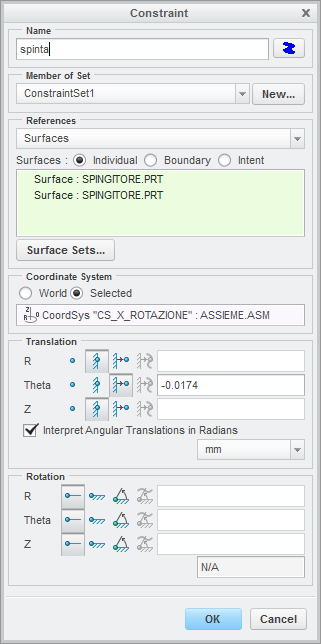
This raises the question regarding what the units of Theta are if the check box is left Unchecked.
I haven't time to guess and have asked the question.
bfn
- Mark as New
- Bookmark
- Subscribe
- Mute
- Subscribe to RSS Feed
- Permalink
- Notify Moderator
To hijack Donald's thread once more to update with info after back and forth discussion with CS.
Case #12927694: "Enforced theta displacement constraints demonstrate unusual behaviour”
11.2.16 [R&D feedback : Works-to-specs. ,,,
After a somewhat confused (possibly me) exchange with R&D via CS, I now understand. During the conversation it seems I upset someone in R&D; this was not my intention. However, as I stated to CS,
'For me (and others) the dialogue is not clear.
Logically, if it were, I would not have raised the call.'
My plain English explanation for lowly engineers like myself (and apologies again to those for whom this is obvious) is below:
Some simple maths/pictures:


In words,
- If 'interpret angular translations in radians' is CHECKED then the number entered is in RADIANS, For a 40deg movement, the user should enter 0.698132 (radians)
- If the check box IS NOT CHECKED then the number entered into the dialogue IS NOT degrees. IT IS mm.
- If the check box IS NOT CHECKED, the number the user enters is the distance is the distance along the subtended arc indicated above. The user must perform the hand calc shown and enter the distance along the arc in mm. (minus sign to get the rotation direction correct)
Even with this clarification, getting a model to run and provide sensible answers becomes the problem. Having spent several hours playing with contact, SDA (small deflection), LDA and mesh options watching timesteps cut and cut again followed by acceptance of huge residual norms and then failure on the third timestep with complaints about buckling modes that cannot exist even though I have ridiculously tiny timesteps (10^-4),
If I suppress the block which is to be pushed, remove all contacts, simplify simplify simplify so only the part that rotates and the base for reference remain (for visual reference), the study fails, Time steps again cut and cut and cut when there are no forces to balance.
In this simplified state, SPA small and large deflection both run if I don't use timesteps and rely on the default 0-1 ramp function !!?
Viewing the SPA results attained and visualising scale=1, overlaying undeformed, the angular movement visually appears about right (although different between Small def and LDA) Additionally, the rotated SPA part is visualised as growing in length, a known oddity of the PP functionality that doesn't appear to be shared by visualistation of LDA results.

The radial movement (elongation of the part) must be ZERO when measured in the radial csys placed at the hole axis.
Radial displacements are not zero. SPA small deflection radial deflections seems to be about zero but SPA LDA is reporting non-zero numbers increasing toward the tip. I can't unravel the 21.1276 number.
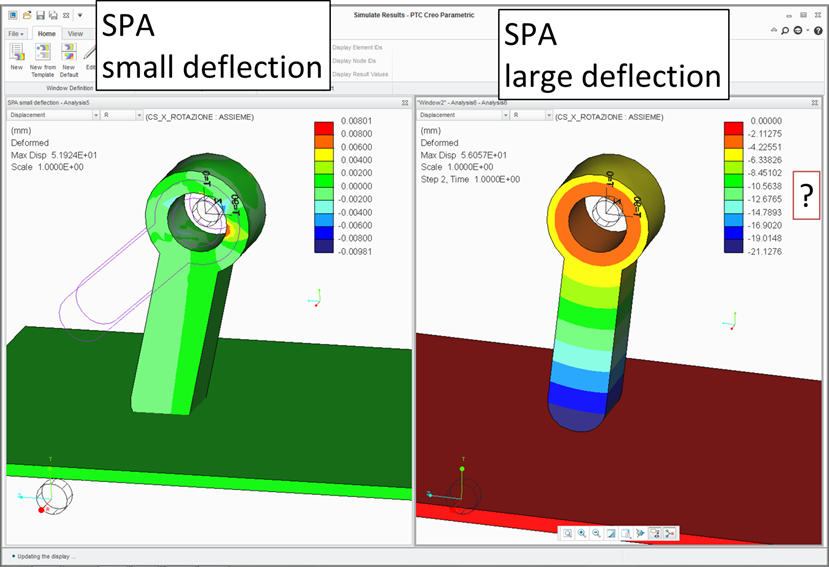
So, I looked at the angular displacement plots for SPA and LDA. Querying the angular displacement at the hole surface where the enforced displacement constraint was applied gives THETA = 6.981 mm. This number is the same as the required arc distance entered in the constraint dialogue. The tip displacement is correct also.
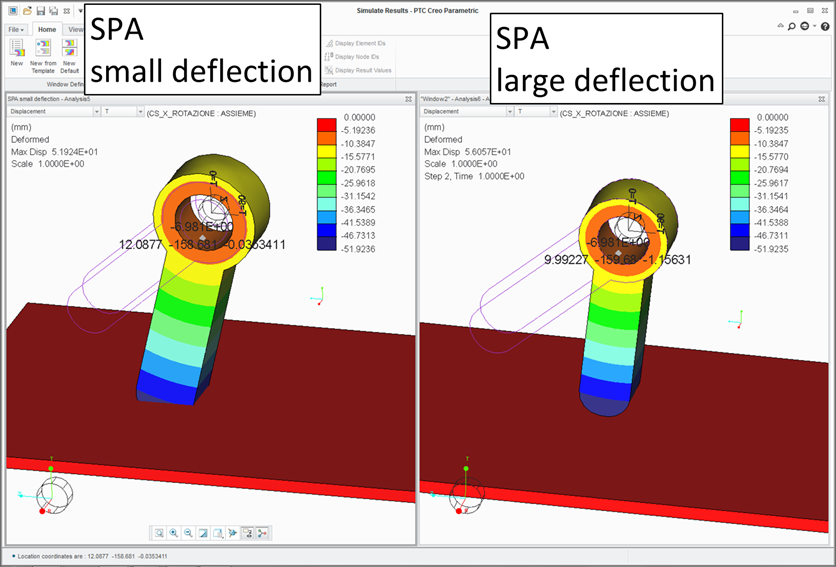
I then noted that I can't get Cartesian position queries for the tip to stack up properly.
Something isn't working properly.
At the moment I have to conclude not to use Simulate will not run this type of study and avoid enforced angular displacements, if you do use enforced angular displacements then treat the output with suspicion; in particular radial displacements.
I haven't tested in Creo2.0 and not sure if it's my job.
Lastly,
My original call is closed but there is an open spr arising. I don't know whether the spr has anything to do with disambiguation of the dialogue or something else as I believe the check box question to be answered.
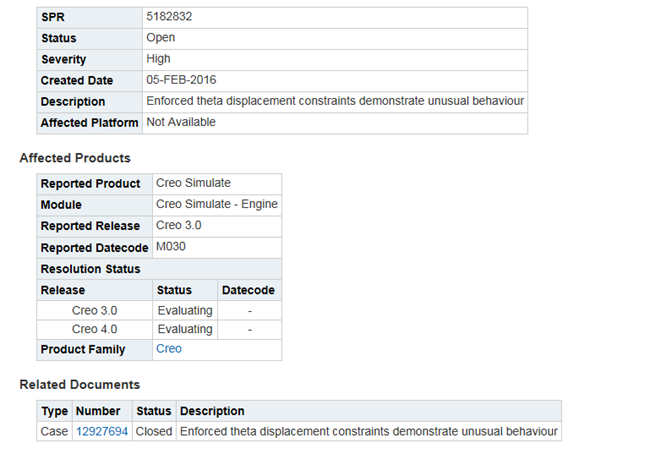
Should I raise a call(s) for this latest stuff and if I do, how much time should I spend not doing business in order to communicate all this with first level support?
As always, I am more than happy to hang my head in shame if I have missed the obvious or have blundered in a public and embarrassing manner.
atb
Charles
,
- Mark as New
- Bookmark
- Subscribe
- Mute
- Subscribe to RSS Feed
- Permalink
- Notify Moderator
Oh dear,
I have just spotted this.
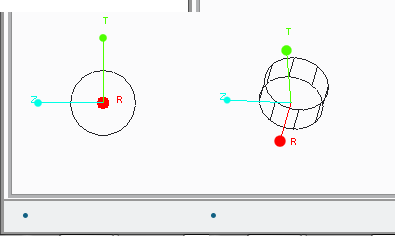
It probably makes no difference to the results but it doesn't help confidence.
- Mark as New
- Bookmark
- Subscribe
- Mute
- Subscribe to RSS Feed
- Permalink
- Notify Moderator
Great work Charles!
We hope that PTC will fix the situation in a future patch inside creo 3 or, at least, in Creo 4.
This is not a "advanced feature" like hyperelastic material; this thing must work.
- Mark as New
- Bookmark
- Subscribe
- Mute
- Subscribe to RSS Feed
- Permalink
- Notify Moderator
Charles,
Thanks for looking further into this for us!
Donald Anderson
- Mark as New
- Bookmark
- Subscribe
- Mute
- Subscribe to RSS Feed
- Permalink
- Notify Moderator
Hi,
I have not looked at you model in detail so am guessing a bit.
When something rotates a lot relative to the part and the post processor scales the movement, the view can become 'silly'.
A common example is a poorly constrained pin in a hole. It solves but the pin spins on its axis. Animating the pin makes the pin look like it is expanding.
- Mark as New
- Bookmark
- Subscribe
- Mute
- Subscribe to RSS Feed
- Permalink
- Notify Moderator
Hi charles,
it's not only a question of visualization: around the hole that has to rotate there are high tensions. So there might be something that keeps the position against the rotation.
But what?
Why?
Why this doesn't happen with a linear imposed displacement?
- Mark as New
- Bookmark
- Subscribe
- Mute
- Subscribe to RSS Feed
- Permalink
- Notify Moderator
I've just done my ultimate simulation taking hint to Charles' post.
In the attached 7z file you find the creo files and a little avi.
The thing works but I don't comprehend exactly how.
Meanwhile I don't know how it interprets the enforced angular displacement: degrees, rads, mm, an arc expressed into mm...boh...
I've tried to express the time dependency of the constraints as Charles has done, but it has not worked. Nothing moved.
Furthermore I've changed the surface where I've put the imposed rotation: the external cylindrical one of the hole/pin.
Again, I can't understand why tensions born around the surface utilized for the displacement.
- Mark as New
- Bookmark
- Subscribe
- Mute
- Subscribe to RSS Feed
- Permalink
- Notify Moderator
I have not followed the latest posts above, but here's an example (powerpoint) of Don Anderson's original question. This works fine in Creo 3, moment free constraints on solids using rigid links, enforced displacement, reaction force measure on point constraint, plasticity and LDA combined...
- Mark as New
- Bookmark
- Subscribe
- Mute
- Subscribe to RSS Feed
- Permalink
- Notify Moderator
Here you can see another similar example, but linear and not angular.
Im my opinion there is a bug on this kind of movement.
- « Previous
-
- 1
- 2
- Next »





